MOSFET vs. IGBT
In the world of power electronics, picking the right semiconductor device is very important for improving the performance, efficiency, and reliability of electronic systems. Two popular options are Silicon Insulated Gate Bipolar Transistors (Si IGBTs) and Silicon Carbide Metal-Oxide-Semiconductor Field-Effect Transistors (SiC MOSFETs). Each of these devices has unique features and benefits, making them suitable for different uses. This article will explain the main differences between Si IGBTs and SiC MOSFETs, discussing their characteristics, pros, cons, and how they affect inverter technology, especially in motor drive systems. By understanding these differences, engineers and designers can make better decisions to improve their power electronics projects.
Catalog

Figure 1: MOSFET vs. IGBT
Understanding Si IGBTs and SiC MOSFETs
SiC MOSFETs
Silicon carbide metal-oxide-semiconductor field-effect transistors (SiC MOSFETs) work by controlling the voltage applied to their gate terminal. One of the main benefits of SiC MOSFETs is their strong resistance to thermal runaway, a condition where an increase in temperature leads to further temperature increases, potentially causing device failure. This resistance is largely due to the better heat conductivity of silicon carbide (SiC) compared to regular silicon. The high heat conductivity of SiC ensures effective heat dissipation at the device level, keeping stable operating temperatures even under high power conditions.
This ability to manage heat is very important in environments with high temperatures, such as those found in cars and industrial settings. In these situations, the dependability and efficiency of electronic parts are very important, and SiC MOSFETs provide a strong solution. Their ability to maintain performance and prevent overheating under tough conditions makes them highly desirable for power electronics, where managing heat is a big concern.
Si IGBTs
Silicon-insulated-gate bipolar transistors (Si IGBTs) are semiconductor devices controlled by current, which work by applying a current to the gate terminal. These transistors are commonly used in applications that convert direct current (DC) to alternating current (AC), especially in motor drives. The attraction of Si IGBTs is their ability to handle high currents effectively. They also offer fast switching speeds, which is very important for applications needing quick and precise power control.
Regarding electrical characteristics, Si IGBTs have a high voltage rating, allowing them to operate safely under high voltage conditions. They also have a low voltage drop across the device when conducting current, which leads to lower power losses and better efficiency. Moreover, Si IGBTs have low conductance losses, meaning they use less power when the transistor is in the 'on' state, improving the overall performance of the system.
These qualities make Si IGBTs especially suitable for high-power motor drive applications, such as those in manufacturing systems. Their strong performance in these tough environments is due to their ability to switch large currents and voltages effectively, making them an affordable and dependable choice for controlling high-power motors.
Inverters and Their Impact on Motor Drive Systems
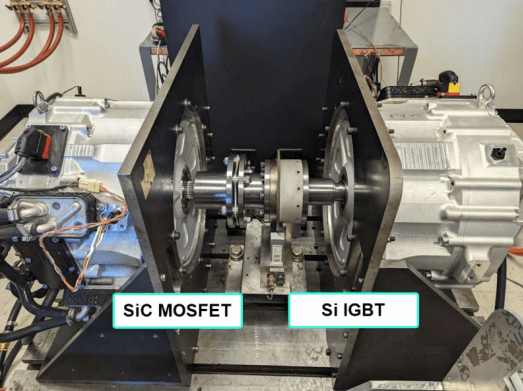
Figure 2: Inverters And Their Impact On Motor Drive Systems
In motor drive applications, inverters play a major part in changing direct current (DC) from battery systems into alternating current (AC), which electric motors need to run. This change is very necessary for electric vehicles, where large battery packs give the DC power needed. Inverters handle many important parts of motor performance, including speed, torque, power, and efficiency. They also help with regenerative braking, which is a feature that captures energy during braking and sends it back into the battery, making the whole system more energy-efficient.
The type of inverter used greatly affects how well the motor drive system works. Historically, two types of inverters have been widely used: Silicon Insulated Gate Bipolar Transistors (Si IGBTs) and Silicon Carbide Metal-Oxide-Semiconductor Field-Effect Transistors (SiC MOSFETs).
Si IGBTs have been the standard choice because they are reliable and the manufacturing processes for them are well-established. However, SiC MOSFETs are becoming more popular because they perform better. SiC MOSFETs have lower switching losses, better heat conductivity, and can work at higher frequencies and temperatures compared to Si IGBTs. These advantages lead to better efficiency, less need for cooling, and the ability to design smaller and lighter motor drive systems.
At first, the high cost of SiC MOSFETs limited their use to high-end or special applications. However, improvements in manufacturing technology and mass production have greatly reduced the cost of SiC devices, making them a practical and attractive option for a wider range of motor drive applications. This cost reduction, along with their performance benefits, has led to more use of SiC MOSFETs in various industries, including automotive, industrial automation, and renewable energy sectors.
Advantages and Disadvantages of Si IGBTs and SiC MOSFETs
Si IGBTs (Silicon Insulated Gate Bipolar Transistors)
Silicon Insulated Gate Bipolar Transistors (Si IGBTs) are widely used in high-power applications due to their strong performance traits. Here’s a detailed look at their advantages and disadvantages:
• Advantages of Si IGBTs
Handles Large Currents Well: Si IGBTs are very good at managing large currents efficiently. This makes them a good choice for applications that need to handle large power loads, such as industrial machinery and electric vehicles.
Fast Switching Speed: Si IGBTs can switch on and off quickly, which improves their performance in systems that need quick changes in current flow. This fast switching ability is helpful for applications that require rapid changes, leading to better responsiveness and performance.
Low Cost: The production process for Si IGBTs is mature and well-established, resulting in lower production costs. This cost advantage makes Si IGBTs a budget-friendly choice for many high-power applications, keeping overall system expenses down.
Can Handle High Voltages: Si IGBTs can withstand high voltages, making them suitable for applications that operate at high voltage levels. This ability is particularly useful in power transmission and distribution systems where high voltage endurance is needed.
Low Energy Loss: Si IGBTs have minimal voltage drop and conductance losses when conducting current. This efficiency translates into reduced energy loss and improved overall system performance, which is good for maintaining high efficiency in power-sensitive applications.
• Disadvantages of Si IGBTs
Prone to Overheating: In high-power applications, such as those in electric vehicles or industrial systems, Si IGBTs can overheat. This overheating can lead to thermal runaway, a condition where rising temperature causes further increases in temperature, potentially leading to device failure. This risk of thermal issues poses a reliability concern in high-power situations.
Slower Turn-off Times: Compared to some newer semiconductor devices, Si IGBTs take longer to turn off. This slower turn-off can limit their effectiveness in applications that need very fast switching, such as high-frequency inverters or advanced motor control systems. The slower turn-off time can lead to increased switching losses and reduced overall efficiency in such applications.
SiC MOSFETs (Silicon Carbide Metal-Oxide-Semiconductor Field-Effect Transistors)
In motor drive applications, choosing between Silicon Insulated Gate Bipolar Transistors (Si IGBTs) and Silicon Carbide Metal-Oxide-Semiconductor Field-Effect Transistors (SiC MOSFETs) greatly affects the system's performance and efficiency. Understanding the pros and cons of SiC MOSFETs helps explain why they are becoming a popular choice in many high-performance applications despite some challenges.
• Advantages of SiC MOSFETs
Higher Efficiency: SiC MOSFETs have lower conduction and switching losses compared to Si IGBTs. This improved efficiency reduces energy consumption and boosts the overall performance of the motor drive system. Lower losses mean less energy is wasted as heat, leading to more effective power use.
Better Heat Management: Silicon carbide conducts heat better than silicon. This allows SiC MOSFETs to handle heat more effectively, keeping up their performance and reliability even under high-power conditions. Better heat management reduces the need for extensive cooling systems, making design simpler and cutting costs.
Faster Switching: SiC MOSFETs can operate at much higher switching frequencies than Si IGBTs. Faster switching allows for more precise control of the motor and can improve performance in applications needing quick switching. This is especially useful in electric vehicle drives and industrial motor control, where efficiency and quick response times are very important.
Higher Voltage Handling: SiC MOSFETs can manage higher voltages than Si IGBTs, making them suitable for high-voltage applications. This higher voltage tolerance is useful in power grid interfaces and high-power industrial drives, where strong voltage handling is needed.
Smaller Size: Due to their better efficiency and heat properties, SiC MOSFETs can be made smaller than their silicon counterparts. This size reduction is good for creating more compact and lightweight systems, which is particularly valuable in applications like electric vehicles, where saving space and weight is very important.
• Disadvantages of SiC MOSFETs
Higher Cost: Making SiC MOSFETs is more complex and expensive than making Si IGBTs. This higher production cost leads to a higher purchase price, which can be a barrier, especially in cost-sensitive applications. However, as manufacturing improves and larger quantities are produced, these costs are gradually decreasing.
Limited Market Use: As a newer technology, SiC MOSFETs have not yet been adopted as widely as Si IGBTs. This limited use can result in fewer available components and less support, making it harder for engineers to find parts and get technical help. Over time, as SiC technology becomes more common, this limitation is expected to lessen.
Complex Drive Needs: SiC MOSFETs often need more advanced drive circuitry compared to Si IGBTs. The complexity of this drive circuitry can complicate the overall system design and possibly increase development costs. Engineers must carefully design and implement these circuits to fully benefit from SiC technology.
Improved Inverter Technology with SiC MOSFETs
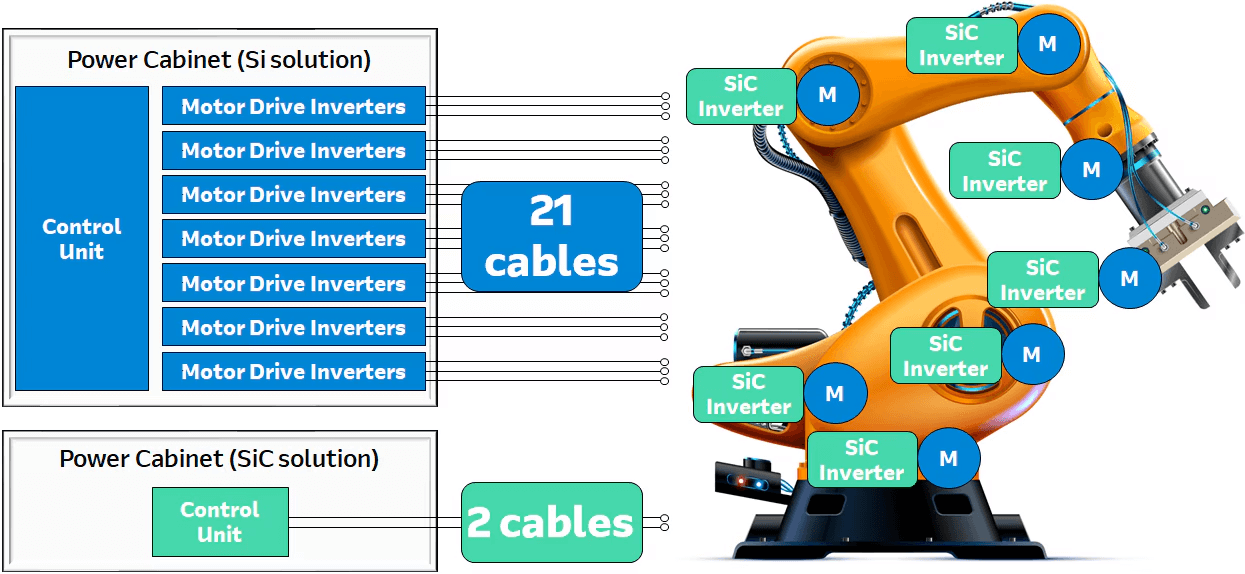
Figure 3: Comparison of Power Cabinet Si Solution vs. SiC Solution for Motor Drive Inverters
Silicon carbide MOSFETs (SiC MOSFETs) have greatly improved inverter technology in motor drive systems, offering many benefits over silicon insulated gate bipolar transistors (Si IGBTs). SiC MOSFETs can work at much higher switching speeds due to their lower switching losses, allowing for more accurate control of motor speed and torque. They also handle heat better, which means they get rid of heat more effectively and reduce the need for large cooling systems. This leads to smaller and lighter inverter designs, which is especially good for electric vehicles.
SiC MOSFETs can also work at higher temperatures, increasing the reliability and lifespan of motor drive systems in tough conditions. While Si IGBTs may still be used in cheaper applications or where high switching speeds and heat management are less of a concern, the efficiency, better heat handling, and higher performance of SiC MOSFETs make them perfect for high-performance and reliable motor drive applications, including electric vehicles and industrial automation.
Main Differences Between IGBTs and MOSFETs
|
Parameter |
IGBT |
MOSFET |
|
Voltage Range |
600V to 6500V (common high voltage applications) |
20V to 1000V (common low to medium voltage applications) |
|
Typical Applications |
High voltage, high current applications, e.g., power grids, industrial
motors, and inverters |
Low to medium voltage applications, e.g., power supplies, audio
amplifiers, and motor controllers |
|
On-State Voltage Drop (V<sub>CE</sub> or
V<sub>DS</sub>) |
Higher voltage drop, typically 2V to 4V |
Lower voltage drop, typically 0.1V to 1V |
|
Switching Speed |
Slower switching speed (more suitable for lower frequency
applications) |
Faster switching speed (more suitable for high frequency applications) |
|
Conduction Losses |
Higher due to bipolar nature and higher voltage drop |
Lower due to unipolar nature and lower voltage drop |
|
Switching Losses |
Higher due to slower switching speed |
Lower due to faster switching speed |
|
Thermal Stability |
Better thermal performance at higher power levels |
Limited thermal performance compared to IGBTs |
|
Control Complexity |
Easier gate drive requirements, typically voltage-controlled |
Requires more complex gate drive circuits, typically
current-controlled |
|
Ruggedness |
Generally better short-circuit withstand capability |
Typically lower short-circuit withstand capability |
|
Cost |
Generally higher for equivalent voltage ratings |
Generally lower for equivalent voltage ratings |
Type of Device
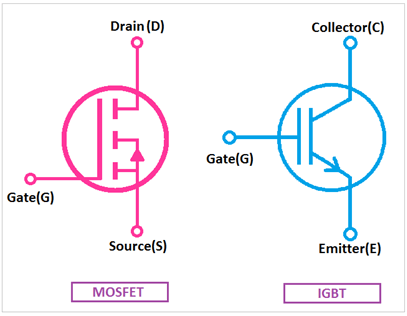
Figure 4: Type Of Device - MOSFET And IGBT Symbol Comparison
IGBTs (Insulated Gate Bipolar Transistors) are a mix of MOSFETs (Metal-Oxide-Semiconductor Field-Effect Transistors) and bipolar transistors. They have a voltage-controlled gate like MOSFETs, which makes switching easy. They also have bipolar-like current-carrying ability, allowing them to handle high power levels. MOSFETs, in contrast, are only voltage-controlled transistors. The flow of current between their source and drain terminals is controlled by the voltage applied to the gate.
Voltage Rating
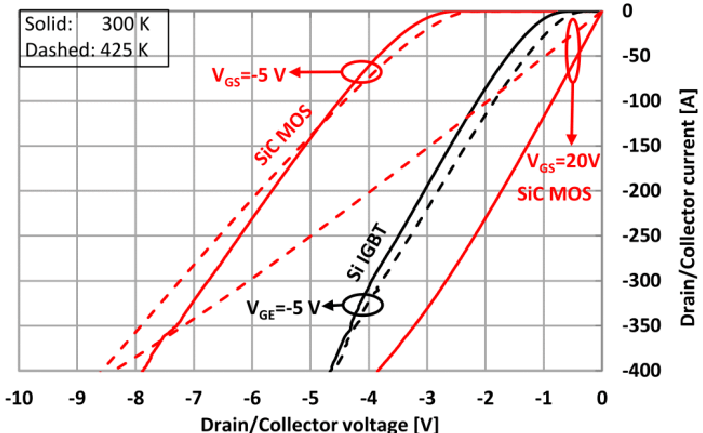
Figure 5: Drain/Collector Voltage Vs. Current For MOSFET And IGBT
For voltage rating, IGBTs are better for high-voltage uses, ranging from hundreds to thousands of volts. This makes them suitable for high-power applications like motor drives and power inverters. MOSFETs are usually used in lower to medium voltage applications, ranging from tens to hundreds of volts, which are common in electronic switching circuits and voltage regulators.
Current Handling
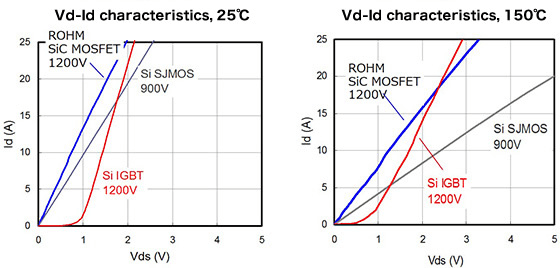
Figure 6: Vd-Id Characteristics At 25°C And 150°C for MOSFET And IGBT
In terms of current handling, IGBTs are great for high current applications because of their bipolar current-carrying capability. This makes them useful in high-power settings. MOSFETs, however, are typically used for lower to moderate current applications, where high efficiency and fast switching are needed.
Switching Speed
Switching speed is another big difference. IGBTs switch slower than MOSFETs, which is fine for applications where fast switching is not needed. On the other hand, MOSFETs are made for high-frequency use, offering faster switching speeds. This makes them suitable for applications like power supplies and converters that need quick and efficient switching.
Efficiency
Efficiency varies between IGBTs and MOSFETs based on voltage and current levels. IGBTs have lower conduction losses at high voltages and currents, making them more efficient in high-power applications. MOSFETs, however, are more efficient at low voltages and currents due to their low on-resistance and fast switching capabilities.
Applications

Figure 7: MOSFET Basic Structure Vs. IGBT Basic Structure
The uses of these devices reflect their strengths. IGBTs are commonly used in high-power situations such as motor drives, power inverters, and induction heating systems due to their ability to handle high voltage and current. MOSFETs are better for applications that prioritize fast switching and efficiency at lower power levels, such as electronic switching circuits and voltage regulators.
Gate Drive Requirements
Lastly, gate drive requirements differ between IGBTs and MOSFETs. IGBTs need a positive voltage on the gate relative to the emitter to turn on, and turn off by reducing the gate voltage. MOSFETs, however, need a positive voltage on the gate relative to the source for both turning on and off, making their gate drive simpler and more straightforward.
Conclusion
Both Si IGBTs and SiC MOSFETs have unique strengths that suit different high-power applications. Si IGBTs are great at handling large currents and high voltages and are cheaper to produce, making them reliable for traditional uses like industrial motors and power grids. However, they can overheat and switch slower, which can be a problem in high-speed or very hot environments.
On the other hand, SiC MOSFETs handle heat better, switch faster, and are more efficient, making them a favorite for modern uses like electric cars and high-performance industrial systems. Although they cost more at first and need more complex drive circuits, ongoing improvements in SiC technology are reducing these issues, leading to wider use.
The choice between Si IGBTs and SiC MOSFETs depends on the specific needs of the application, such as voltage and current levels, speed of switching, and heat management. By using the strengths of each device, engineers can design and build better power electronic systems, driving improvements and efficiency in various technology fields.
Frequently Asked Questions [FAQ]
1. Which is better IGBT or MOSFET?
The choice between IGBT and MOSFET depends on what you need it for. MOSFETs are generally better for low to medium power tasks that need fast switching speeds and good heat management. They are good for things like power supplies and motor controllers. IGBTs, on the other hand, are better for high-power tasks because they can handle larger currents and higher voltages, making them ideal for industrial motors and power inverters.
2. Can IGBT replace MOSFET?
Sometimes, IGBTs can replace MOSFETs, especially in high-power tasks where handling large currents and voltages is very needed. However, because IGBTs switch slower and handle heat differently, they might not be good for tasks that need very fast switching and low power loss, where MOSFETs are better.
3. How do I know if I have IGBT or MOSFET?
To find out if you have an IGBT or MOSFET, check the part number and details from the maker. Datasheets will tell you if the device is an IGBT or a MOSFET. They may look alike, so you need to check the documentation or markings on the component.
4. Which is the fastest switching device IGBT or MOSFET?
MOSFETs are generally the fastest switching devices compared to IGBTs. They can switch at much higher speeds, which makes them suitable for tasks that need quick switching, like in power supplies and high-frequency inverters.
5. How do I know if I have IGBT or MOSFET?
You can find out whether you have an IGBT or MOSFET by looking at the component's markings and comparing them with datasheets or maker details. These documents give detailed information about the type of semiconductor device, including whether it is an IGBT or a MOSFET.